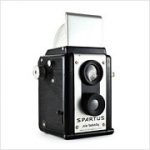Kodak Jiffy Six 20 Specifications
| Manufacturer: | Eastman Kodak Company |
| Origin: | USA |
| Made in: | Rochester, NY, USA |
| Introduced: | 1933 |
| Type: | Folding, Viewfinder |
| Format: | 620 Film |
| Dimensions: | 8.2 x 15.8 x 3.8 cm (closed) |
| 8.2 x 15.8 x 12 cm (open) |
Kodak Jiffy Six 20 Overview
When it was introduced, the Kodak Jiffy Six 20 was marketed by Eastman Kodak as the simplest, most user-friendly folding camera ever made. Up until that point, most folding cameras were of the same basic design (example: Kodak No. 3A Autographic). They were relatively difficult to handle, complex, and required users to manually unfold the camera and extend the lens in order to take photos. In the spirit of simplicity, the Jiffy boasts a simple two button operation. The first small metal button can be found on the film advance knob’s side of the camera and releases the front plate, causing the metal struts on either side to snap into place and automatically extend the lens. The second button is the shutter lever which can be found on the side of the front plate once extended.
The Jiffy’s Twindar 105mm f/8 lens has two focus zones: 5-10 feet and 10 feet to infinity which can be selected by rotating the lens. Three aperture settings: f/8, f/11, and f/16 are also available and can be changed by pulling or pushing a metal tab on the side of the lens plate. There are only two shutter speeds: I for “Instant” (approximately 1/50 seconds) and T for “Time” (first shutter press opens the the shutter, second shutter press closes it). Like many cameras of the era, the Kodak Jiffy has two waist-level viewfinders: one for portrait and the other for landscape. There is also a kickstand that folds out from behind the lens plate which allows the camera to stand on its own. Unfortunately, the kickstand’s usefulness appears to be limited as the camera does not accept any kind of shutter release cable.
Kodak’s Jiffy came in four flavors during its 15 year production run. The original Jiffy features an Art Deco design on the front plate and a kickstand that only supported the camera in portrait orientation while the Series II model was completely clad in plain black leatherette and featured a modified kickstand that could accommodate landscape orientation as well. Both series of this camera were offered in two different formats: Jiffy Six 20 for 620 film and Jiffy Six 16 for 616 film. Besides the format, a few cosmetic changes and the aforementioned kickstand evolution, all four incarnations of the Kodak Jiffy seem to be pretty much identical.
My wife and I actually have three examples of the Six 20 between us: one original Jiffy and two Series II models. The two Series II cameras came first; the first was purchased for about ten dollars at a thrift store while the second one was given to me by my brother who wasn’t aware that I already owned one. Then I bought the third Jiffy (the beautiful “Series I” pictured above) as a Valentine’s Day gift for my wife. What can I say, I’m a sucker for folders.
Find your very own Kodak Jiffy Six 20 on eBay.
McKeown, James M. and Joan C. McKeown’s Price Guide to Antique and Classic Cameras, 2001-2002. (Grantsburg, WI, USA: Centennial Photo Service, 2001), p 350.

















